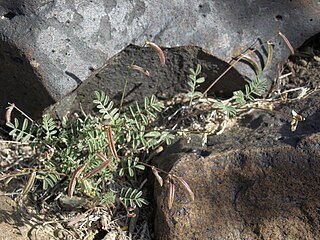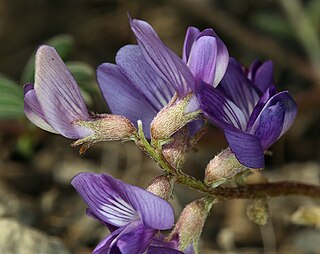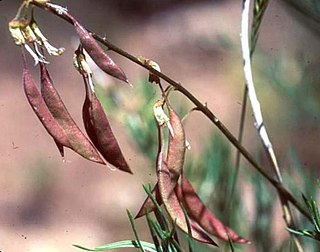
Astragalus acutirostris is a species of milkvetch known by the common name sharpkeel milkvetch. It is native to the Mojave Desert and surroundings of California, Nevada, and Arizona, where it grows in dry, sandy, gravelly areas.

Astragalus gilmanii is a species of milkvetch known by the common name Gilman's milkvetch. It is native to the desert scrub and woodland of Nevada, the California Sierra Nevada and Inyo Mountains, and it is known from a few locations in the Panamint Range adjacent to Death Valley in California.

Astragalus inyoensis is a species of milkvetch known by the common name Inyo milkvetch.
Caulanthus hallii is a species of flowering plant in the family Brassicaceae known by the common name Hall's wild cabbage.

Hoita strobilina is a rare species of legume known by the common name Loma Prieta leatherroot, or Loma Prieta hoita. It is endemic to California, where it is known from occasional occurrences in the San Francisco Bay Area. It grows in chaparral and woodland habitats in the local mountains, often on serpentine soil. This is a perennial herb growing erect, approaching a meter in maximum height. The large leaves are divided into three leaflets each up to 8 centimeters long and lance-shaped to nearly round. The herbage is generally glandular and hairy. The inflorescence is a raceme up to 13 centimeters long containing many pealike flowers. Each flower is purple, sometimes with white parts, and one to two centimeters long. The fruit is a dark brown or black, hairy, veiny legume pod.

Acmispon grandiflorus, synonym Lotus grandiflorus, is a species of legume native to western North America. It is known by the common name chaparral bird's-foot trefoil.

Acmispon micranthus is a species of legume native to California and northwestern Mexico. It is known by the common name San Diego bird's-foot trefoil. It is found in the coastal mountain ranges of California and Baja California, where it grows in various types of scrub and canyon habitat. It is an annual herb taking a spreading or upright form. It is lined with leaves each made up of oval leaflets each about a centimeter long. The inflorescence is a small bunch of red and yellow flowers. Each flower is in a tubular calyx of sepals and is only a few millimeters long. The fruit is a narrow, bent legume pod up to 1.5 centimeters long, including the hooked beak at the tip.
Acmispon haydonii, synonyms Lotus haydonii and Syrmatium haydonii, is a species of legume native to California It is known by the common names pygmy lotus, rock bird's-foot trefoil and Haydon's lotus.
Hosackia incana, synonym Lotus incanus, is a species of legume native to California. It is known by the common name woolly bird's-foot trefoil. It is endemic to the Sierra Nevada of California, where it grows in forests and other mountain habitat.
Acmispon junceus, synonyms Lotus junceus and Syrmatium junceum, is a species of legume native to California. It is known by the common names rush broom and rush deervetch. It is endemic to California, where it is known from the northern and central coast and the coastal mountain ranges. It can be found from beaches inland to serpentine slopes and chaparral. It is a hairy, prostrate or spreading perennial herb lined with leaves each made up of small oval leaflets. The inflorescence bears up 8 yellow pealike flowers each up to about a centimeter long. The fruit is a small beaked legume pod.

Acmispon parviflorus, synonym Lotus micranthus, is a species of legume. It is known by the common name desert deervetch. It is native to western North America from British Columbia to southern California, where it is known from many types of habitat. It is a hairy to hairless annual herb lined with leaves each made up of small oval leaflets. Solitary flowers appear in the leaf axils. Each is an ephemeral pinkish pealike bloom under a centimeter long. The fruit is a narrow, hairless, wavy-edged legume pod up to about 2.5 centimeters long.
Hosackia pinnata, synonym Lotus pinnatus, is a species of legume native to western North America from British Columbia to California. It is known by the common names meadow bird's-foot trefoil and bog bird's-foot trefoil. Its distribution extends into British Columbia in just a few rare occurrences near Nanaimo. It grows in moist to wet habitat, such as bogs and spring meadows. It is a hairless perennial herb lined with leaves each made up of green oval leaflets each 1 to 2.5 centimeters in length. The inflorescence is an array of up to 10 pealike flowers between 1 and 2 centimeters long. Each flower has a bright yellow banner, or upper petal, and white lower petals. The fruit is a slender, elongated legume pod up to 5 centimeters long but just a few millimeters wide.

Hosackia stipularis, synonym Lotus stipularis, is a species of legume endemic to California. It is known by the common name balsam bird's-foot trefoil. It is found in most of the northern and central coastal and inland mountain ranges and foothills. It can be found in many types of habitat, including forest, chaparral, and disturbed areas. This is a mostly erect perennial herb with a leafy, often hairy and glandular form. Its slender branches are lined with leaves each made of several leaflets up to 2 centimeters long. The leaves sometimes have prominent stipules. The inflorescence is a compact array of up to 9 pink flowers. Each flower is elongated, the corolla borne in a tubular calyx of sepals, and the entire unit may exceed a centimeter long. The fruit is a legume pod 2 or 3 centimeters long containing several beanlike seeds.
Harmonia hallii is a species of flowering plant in the family Asteraceae known by the common names Hall's harmonia and Hall's madia.
Rupertia rigida is a species of flowering plant in the legume family known by the common name Parish's California tea, or Parish's rupertia.

Senna armata is a species of flowering plant in the legume family known by the common names spiny senna and desert senna. It is native to the desert regions around the intersection of Nevada, Arizona, eastern California and northern Baja California, where it grows in sandy and rocky habitat, such as arroyos. It is a shrub growing up to a meter tall, its grooved, branching stems often narrowing to thorns at their tips. The spiny branches are coated in tubular hairs which help protect it from hot desert air. The spine-tipped leaves are each made up of two to four pairs of small leaflets. The leaves are ephemeral, dropping soon after emerging, leaving the shrub naked most of the time. Flowers occur singly or in small clusters in leaf axils. They are fragrant and showy, with five petals in shades of yellow to salmon pink, each measuring roughly a centimeter long. The fruit is a legume pod up to 4 centimeters long.

Senna didymobotrya is a species of flowering plant in the legume family known by the common names African senna, popcorn senna, candelabra tree, and peanut butter cassia. It is native to Africa, where it can be found across the continent in several types of habitats.

Tetracoccus hallii is a species of flowering shrub in the family Picrodendraceae, known by the common names Hall's shrubby-spurge and Hall's tetracoccus.

Schoenoplectiella hallii is a species of flowering plant in the sedge family known by the common name Hall's bulrush. It is native to the United States, where it has a disjunct distribution, occurring in widely spaced locations throughout the Midwest and East. It is a rare plant.

Astragalus ripleyi is a species of flowering plant in the legume family known by the common name Ripley's milkvetch. It is native to southern Colorado and northern New Mexico in the United States.













